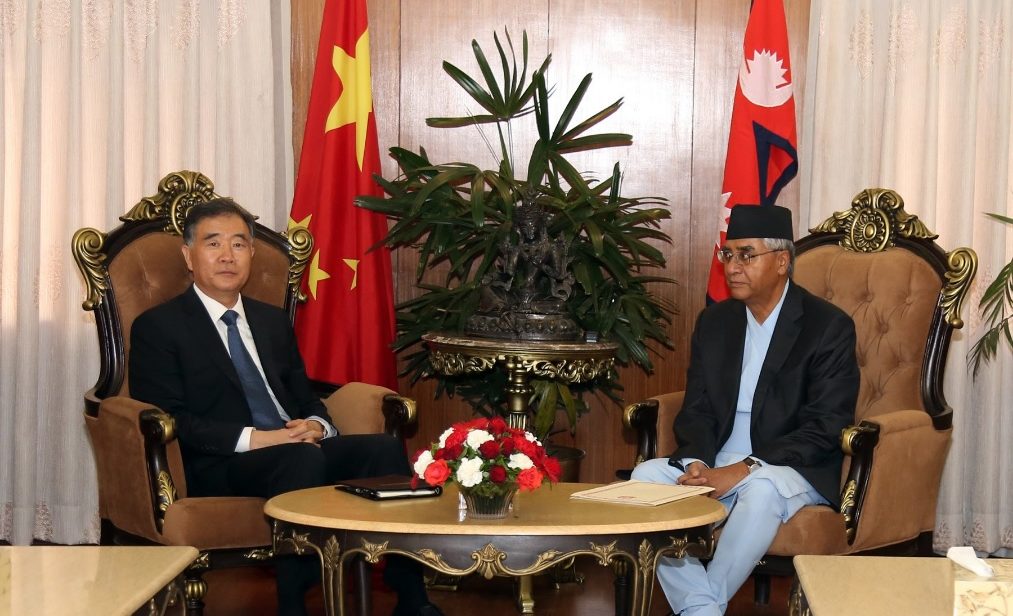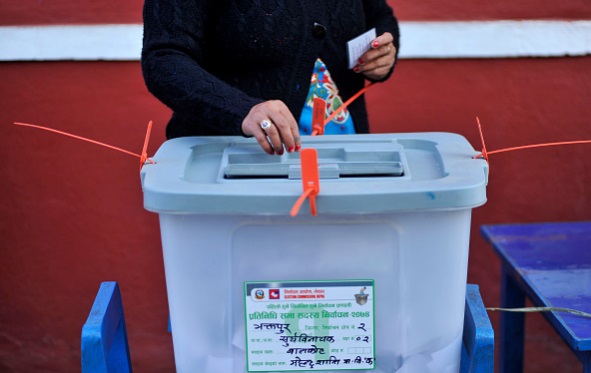
After 57 years of political struggle for a multiparty democracy and a people’s constitution, including ten years of a Maoist insurgency, Nepal adopted its first democratic constitution in September 2015. The process formally ended the monarchy, the Maoist conflict, and the prolonged debate over the new constitution, all of which had stalled economic growth and infrastructure development in the country.
Nepal formalized the new constitution by holding federal and provincial elections recently. The Left Alliance registered a comfortable majority in the Parliament earlier this week, with the mandate for political stability and development. A strong government in Kathmandu and a popular constitution have raised people’s expectations that the country will now finally move forward. However, given its geo-economic constraints, the new foreign policy of Nepal should be centered on meeting domestic requirements like energy and food security, climate change, and the modernization of security forces while at the same time maintaining an independent foreign policy, which is emphasized in the Constitution. To this end, the new government could take advantage of the strategic competition between China and India and employ effective bargaining tactics in order to satiate the strong domestic appetite for rapid infrastructure and economic growth.
Electorate Expectations and Foreign Policy
Unlike the 2008 and 2013 parliamentary elections, issues like political stability, economic and infrastructure development, and migration dominated the 2017 electoral debate in Nepal. In the months leading up to the election, voters demanded better roads, jobs, hospitals, schools, and electricity and asserted that development mattered more than ideology. Many committed cadres of both alliances said they would not support their party’s candidates unless assured of development in their region. Keeping this in mind, both alliances promised rapid economic growth in their manifestos if voted into power.
The election manifestos of the two major political coalitions—the Left Alliance (LA), led by the Communist Party of Nepal (Unified Marxist-Leninist) (CPN-UML), and the Democratic Alliance (DA), led by the ruling Nepali Congress (NC)—clearly indicated the weight given to maintaining friendly relations with both China and India, with an objective of reaping economic gains from neighbors. While the DA, which is perceived to have a pro-India tilt, mentioned “balanced relations” by giving due attention to the sensitivities of two neighbors, LA remained notably silent on its stance towards Beijing and New Delhi. The LA’s foreign policy is more aggressive and nationalistic in nature, with emphasis on maintaining an independent foreign policy, free from foreign interference in the internal affairs of Nepal. The party projects India as an interfering neighbor and has categorically mentioned it will review Nepal’s unequal treaties with India. In fact, before the 2017 elections and even during the campaign, the LA’s top leaders indirectly hinted that China’s Belt and Road Initiative (BRI) could support rapid economic and infrastructure development in Nepal.
The political parties’ open support to the BRI despite being aware of India’s reservations indicates that Kathmandu may not be dependent on India for trade, transit, and infrastructure development. In fact, a few months after the Nepali government blamed India for supporting the four-month Madhesi blockade of the Indo-Nepali border in late 2015/early 2016, Kathmandu signed a transit agreement with China to open up alternate supply routes. Thus, Nepali leaders and policymakers believe that India will likely not be able to impose another blockade in the near future, which means that the new government in Kathmandu may no longer behave like a junior partner, both at the bilateral and multilateral level and can bargain as an equal with both India and China.

Challenges Ahead
Resource constraints will remain a major obstacle for Nepal in achieving its development goals and thus, it needs the support of both China and India. However, New Delhi and Beijing suspect each other’s engagements in Nepal and this may present its own set of challenges for Kathmandu.
A World Bank study suggests that Nepal needs an investment-to-Gross Domestic Product ratio of 25 percent on average from 2017 to 2030 in order to become a middle-income country while another estimates that Nepal needs to spend $13 to $18 billion from 2011 to 2020 to improve its infrastructure. But from 2001 to 2016, Nepal received an average of only $27 million in Foreign Direct Investment (FDI) per year. For a landlocked country like Nepal, FDI plays a vital role in jobs, industrialization, and infrastructure development. Thus, Nepal is looking to both its southern and northern neighbor for investment.
However, domestic concerns over interference in its internal affairs and managing the sensitivities of both India and China will be a hard task for Nepal. For instance, FDI flow from India, which had historically been the largest investor in Nepal, has shrunk recently due to tensions in bilateral relations and China has stepped in. In March this year, Chinese companies announced that they would invest around $8.3 billion in different sectors in Nepal and in May, Kathmandu agreed to let Beijing develop mega projects in the country under the BRI, despite Indian reservations. These developments have raised eyebrows in New Delhi. In fact, last month, when the ruling NC government scrapped the Budhigandaki hydro project that was given to a Chinese company, the top leaders of the LA not only criticized this decision but vowed to reverse it if voted into power. This action added to the perception in Nepal that China has encouraged the LA to challenge India’s influence in the country to protect its newfound economic and security interests south of the Himalayas. With the LA now forming government in Nepal, its perceived pro-China stance could lead to further deterioration of relations with India and affect Nepal’s FDI inflow.
Concluding Thoughts
Neither China nor India can fully achieve the development aspirations of Nepal on their own. While its southern neighbor offers transit facilities and an easy market for Nepal’s trading activity, its northern neighbor has the ability to extend technological and financial support.
Given the unfolding regional competition between China and India, the new government in Kathmandu could use its bargaining power to its advantage by drawing investments from both its neighbors. It will also be a litmus test for the new government: the ruling party will have to show that it can strike a balance between the country’s domestic aspirations and neighbors’ sensitivities.
Image 1: Via Prime Minister Deuba’s Twitter account
Image 2: Narayan Maharjan/NurPhoto via Getty


